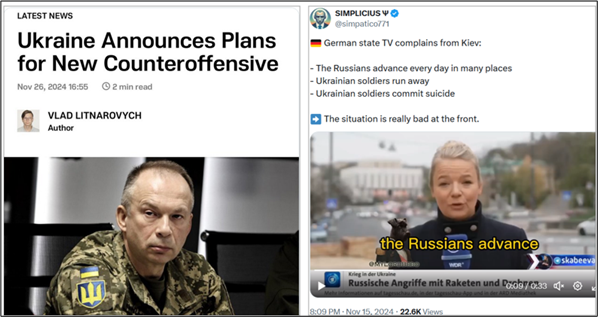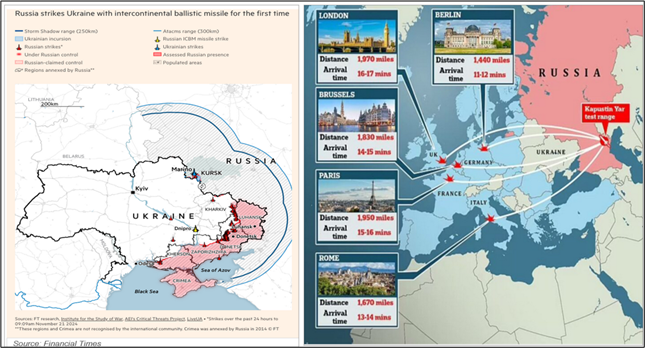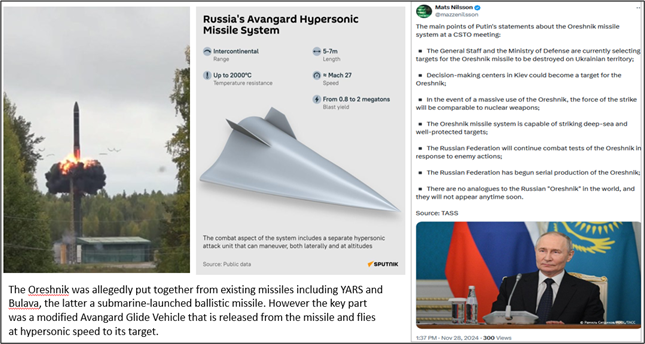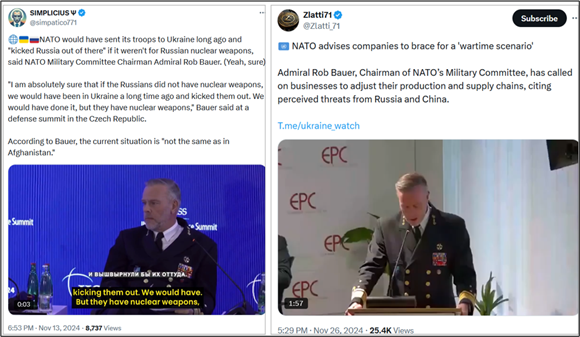Counting weeks to the final curtain in Ukraine
In my previous article regarding the war in Ukraine, “And now the end is near…”, I told some figures of losses and now, late November, AFU’s KIA figures are exceeding 900,000. I will disclose new estimates later.
Dramatic moments will be ahead: AFU is militarily collapsing but started desperately launching American ATACMS-missiles deep into Russia (after receiving a permission from President Biden) and Russia replied with a strike of ICBM; moreover, NATO’s top brass is planning ground operations with European forces in Ukraine, even without the US support.
History repeats itself – in military history of Kursk
The moronic duo, Zelensky & Syrskyi, will go down in military history as one of the worst examples. They sent the elite AFU brigades, well equipped with western hardware, into the meat grinder, where certain deaths awaited, just for western optics and publicity. They both failed to remember and realize the lessons from WWII regarding the battle in Kursk.

Russian Defense Ministry reports on repelling AFU attempt to invade Russian territory in Kursk region (28 November 2024)
The Armed Forces of the Russian Federation (RuAF) continue the operation to neutralize an enemy group, which broke into the territory of Kursk region. Since the beginning of hostilities in Kursk region, the AFU losses amounted to more than 36,260 troops, 223 tanks, 158 infantry fighting vehicles, 122 armoured personnel carriers, 1,200 armoured fighting vehicles, 1,044 motor vehicles, 304 artillery guns, 40 MLRS launchers, including 11 of HIMARS and six of MLRS made by the USA, 13 anti-aircraft missile launchers, seven transport-loading vehicles, 70 EW stations, 13 counter-battery warfare radars, four air defence radars, 27 units of engineering and other materiel, including 13 counterobstacle vehicles, one UR-77 mine clearing vehicle, six armoured recovery vehicles, and one command post vehicle The operation to neutralize the AFU units is in progress.
The presented casualty figures speak shockingly about the madness of the Kursk operation.
Military situation, end of November
The RuAF resume devastating strikes in Ukrainian rear regions and Ukraine suffered heavy damages as a result of the day/night attacks of Russian drones and missiles. A series of explosions are thundered in the Ukrainian capital. The city of Kiev is coming under attacks daily. The city of Kiev and the Kiev region have been pounded by Russian drones for several nights in a row. The Armed Forces of Ukraine (AFU) suffered heavy losses as a result of Russian strikes in the eastern city of Kharkiv. More strikes were recorded in Odessa and Chernihiv region.
Together with precision strikes in the strategic rear regions, Russian forces are pounding Ukrainian military positions in the war-torn regions. Explosions have thundered in the areas, where military airfields could be targeted all over Ukraine. On Ukrainian frontlines the RuAF are advancing on all parts of the frontline: from Kupyansk to Kherson. Total collapse of AFU is approaching.
Cyber-attacks across Ukraine, the major application (Discord) used by the Ukrainian command, is down nearly daily, command networks have been hacked, air defense systems are not working, Russian drones and heavy bombers are flying in the sky. Simply said, full panic mode in Kiev.

The situation regarding the equipment of the Ukrainian armed forces is catastrophic, with Ukraine losing more than it has received from allies, highlighting a reliance on its own outdated Soviet-era equipment. Given this current situation, gigantic losses and serious lack of manpower, contemplating another counteroffensive could be a far more serious mistake than the previous one (Kursk). Both Russian and European strategists understand that only an international intervention could rebalance the war but with unpredictable consequences and this is the Russian deterrence strategy being applied at this moment.

Zaporizhzhia Offensive BEGINS | Kurakhove Near Collapse | Full Front Offensive
Weeb Union, November 15, 2024
Zelensky Is Furious: Scholz Called Putin💥Kupiansk Defense Has Collapsed⚔️Military Summary 2024.11.16
Harvest Time🔥Ukraine Hit Russia With ATACMS💥Sabotage In The Baltic Sea⚠️ Military Summary 2024.11.19
Harvest Time🔥 ATACMS & Storm Shadow Strike💥 West Braces For Retribution🌏 Military Summary 2024.11.20
Two decisive events have taken place now in the Ukrainian war theater: AFU attacks with American ATACMS -missiles deep into Russia and Russia’s reply using IRBM (intermediate-range ballistic missile with conventional warheads) first time in the war history.

Russia Attacked Ukraine With An ICBM💥The West Urgently Sends Weapons🌏Military Summary For 2024.11.21
Oreshnik That Split The World In Two🌏 Russia Prepares A New Strike💥 Military Summary For 2024.11.22
Preventive “Precision Strikes”💥British And French Troops To Ukraine🔥 Military Summary For 2024.11.26
Harvest Time🔥NATO Fuels Escalation🌏 Russians Prepare Retaliatory Strike💥 Military Summary 2024.11.26
On November 28, the armed RuAF launched another massive strike with drones and missiles, mainly targeting Ukrainian energy infrastructure throughout the country.
Russia’s ballistic missile strike (IRBM) – a game changer
Russia’s new nuclear doctrine
Russian President Putin approved Nuclear Doctrine changes. This comes after President Biden gave Ukraine permission to strike Russia with US missiles. Putin signed a decree on November 19, approving the country’s updated nuclear doctrine, titled the Basic Principles of State Policy of the Russian Federation on Nuclear Deterrence.
Updated doctrine sets out clear conditions for use of nuclear weapons, including scenario in which non-nuclear states’ aggression is backed by nuclear powers. Particular focus is given to Belarus, where any aggression is regarded as an attack on Russia, justifying nuclear retaliation.
The document outlines conditions for the use of nuclear weapons, threats deemed serious enough for use, the order in which the plan for the use of nuclear weapons is activated, decision-makers, actions to keep nuclear forces in combat readiness and policy for “nuclear deterrence”— a plan for preventing nuclear attacks by ensuring that any nuclear aggression results in devastating retaliation. While the principle of nuclear weapons as a last resort for protecting Russia’s sovereignty remains unchanged, the criteria for their use have been revised.
The document highlights potential military threats such as anti-missile systems, military buildups near Russian borders and nuclear weapons stationed in non-nuclear states. For the first time, a “potential opponent” is defined, encompassing states or military alliances that see Russia as a threat and possess significant military power. The list of military threats countered by nuclear deterrence includes 10 key dangers, the most notable of which is the presence of potential adversaries equipped with nuclear or other weapons of mass destruction
The buildup of foreign forces, including nuclear delivery means or related military infrastructure, near Russia’s borders has also been designated as a significant threat. Additionally, the deployment of missile defense, anti-satellite systems, and nuclear weapons on non-nuclear states’ territories is viewed as perilous.
The deterrence includes forming and maintaining up-to-date nuclear forces capable of delivering “guaranteed unacceptable damage” to any adversary, alongside ensuring that all of them have no doubt about Moscow’s readiness and resolve to engage them if necessary. If aggressors attack Russia or its allies, they must be prepared for retaliation, the doctrine states. Aggression by a non-nuclear state backed by a nuclear power will be treated as a joint attack, while any military coalition’s aggression will be seen as the bloc’s collective action.
The President of Russian Federation makes the final decision on nuclear use. He may also inform other nations or international bodies about the readiness or actual use of nuclear weapons. Sergey Markov, a former adviser to President Putin, told that the new doctrine “equalizes conditions with the US,” as the threshold for nuclear weapon use is lower in the West than in Russia. Markov highlighted that the US nuclear doctrine allows the use of nuclear weapons to protect its allies, which Russia had not considered until now.

Oreshnik – IRBM (intermediate-range ballistic missile)
Kiev’s forces launched the strikes on Tuesday (Nov 19) and Thursday (Nov 21), using US-made ATACMS and HIMARS systems as well as British-made Storm Shadow missiles.
Russia’s ballistic missile strike was a response to Ukrainian attacks on military facilities located on internationally recognized Russian territory, Russian president stated.
According to Putin, the response involved a “hypersonic ballistic missile strike with a non-nuclear payload.” The missile struck “one of the biggest industrial complexes, which has been famous even since Soviet times and still produces missiles and other weapons.” The president was apparently referring to Yuzhmash – Ukraine’s state-owned aerospace manufacturer in Dnipro, which it inherited from the Soviet Union. Russia launched the first IRBM combat strike in the military history. Use of the missile has serious implications for Ukraine, NATO and the United States.
The Oreshnik was not any common ballistic missile. It mounted a hypersonic glide vehicle with MIRV/MARV capability. MIRV means Multiple Independently Targeted Reentry Vehicles. MARV means Maneuverable Reentry Vehicle. In the case of the Oreshnik, reports say that the glide vehicle released six warhead packages and each package released six submunitions. This means that up to 36 submunitions hit the Dnipro facility. The Oreshnik was allegedly put together from existing missiles including YARS and Bulava, the latter a submarine-launched ballistic missile. However, the key part was a modified Avangard Glide Vehicle that is released from the missile and flies at hypersonic speed to its target.

Chay Bowes: Russia has options
The fitting of ICBM/IRBMs with non-nuclear warheads is a relatively novel innovation and one which the US Navy has considered under the Prompt Global Strike program. The ranges across which such missiles travel and the high costs needed to accommodate these, mean that using them to deliver conventional attacks has not been considered cost effective in the past. Significant increases to the precision, which can be achieved at such ranges, however, has made conventional attacks using ICBMs increasingly viable.
There is much speculation about the damage done at the Dnipro Yuzhmash aerospace manufacturing facility. However, enough is known to make it clear that this strike on the Dnipro facility had unique characteristics. Eyewitnesses who live in the area near the factory say that there was no fire when the attack struck, yet they felt something like an “earthquake” that “cracked” some houses perhaps a mile away. Likewise, there was no explosion in the conventional sense.
Local witness accounts say the working part of the facility was turned into dust. This suggests that the Oreshnik submunitions crashed at hypersonic speed into the workshops and simply pulverized them. There was no particular need for high explosives to do the job. Kinetic energy of the Oreshnik causes a massive impact.
This has significant implications for underground targets elsewhere, as surely the Ukrainians grasped immediately. In effect, the Russians have put a Damoclean Sword on Zelensky’s head, as he operates from an underground bunker. This suggests that the Yuzhmash target was well chosen to send a warning to Ukraine’s leaders. It also sent a warning to NATO. As Russian President Putin said in a nation-wide address, Oreshnik could hit any target in Europe. Thus, all NATO bases, command centers, and missile sites could be destroyed by Oreshnik. Likewise, the US got a wake-up call insofar as America’s missile bases and air defenses are concerned.
The other “demonstration” from the Orshnik strike was accuracy. It seems Avangard is far more accurate than a “typical” ICBM in that it has a precision guidance system. We don’t know how the Russians are achieving such accuracy. According to the Ukrainians, who have recovered some (few) missile parts from the Dnipro strike, the Oreshnik/Avangard had telemetry onboard. Telemetry is typically used in test vehicles to assess performance. It would appear, therefore, that the Russians probably have a handful of Oreshnik vehicles on hand. President Putin has announced the missile and glide vehicle combo will now enter serial production.

How the new Russian missile, Oreshnik, is changing the game
To describe a weapon system as a game changer on the battlefield is always open to be ridiculed. Many of the western weapon systems that have been delivered to Ukraine were called game changing but failed to make any difference in the outcome of that war.
Firstly, the missile with its 36 kinetic war heads is an unexpected response to the US abolition of the Intermediate Range Nuclear Force (INF) treaty. The US had hoped that the stationing of nuclear missiles in Europe might give it an advantage over Russia. Oreshnik denies that advantage without resorting to nuclear force. Any US attempt to pressure Russia into a situation, where it would either have to concede to the US or to go nuclear has been demolished.
Over two years of the Ukrainian war, the US has used a “boiling the frog” strategy against Russia. It increased the temperature by slowly increasing the reach and lethality of the weapons it has provided to Ukraine. In each such step, the delivery of Abrams tanks, HIMARS, ATAMACs, allowing Ukraine to use these on Russian grounds, was declared to be a move across imaginary Russian red lines. Each such step was accompanied by western narrative that “Russia was looking into a nuclear response”. The aim was to push Russia into a situation, where it could either make concessions over Ukraine or use nuclear weapons. By going nuclear, Russia would lose support from its allies in China and beyond. It would also risk an all-out nuclear war.
The strategy would probably have worked, if Russia had not found an asymmetric way of response but now Russia has non-nuclear weapons, (the Oreshnik will not be the only one), which allow it to apply the equivalent of nuclear strikes without the dirty side effects of actually going nuclear. Russia’s announcement that future Oreshnik deployments will come under the command of its Strategic Forces -which so far have only been nuclear. This is a clear sign that these new weapons are seen as having similar strategic effects.
The kinetic concept of the Oreshnik payload is not a new one. Mass times speed is the amount of destructive energy these can deliver. Being hypersonic and hitting the targets with a speed of Mach 10 or more allows even small penetrators without explosives to have very strong, explosive-like effects.
Russia seems to have solved some general physical problems of objects flying at hypersonic speed. In March 2018 Russia’s president Vladimir Putin announced the introduction of several new weapons designed to penetrate US missile defenses. One of these was the hypersonic glide vehicle now known as Avangard. The use of new composite materials has made it possible to enable the gliding cruise bloc to make a long-distance guided flight practically in conditions of plasma formation. It flies to its target like a ball of fire. The temperature on its surface reaches 1,600–2,000 degrees Celsius but the cruise bloc is reliably guided. Until those basic scientific discoveries become known in the west there will be no chance for it to make weapons that can match the characteristics of Oreshnik and Avangard.
The US missile defense base in Poland has long been considered a priority target for potential neutralization by the Russian Armed Forces. As there is no defense possible against Oreshnik type weapons Russia could announce a strike on the U.S. controlled Redzikow base in Poland days or hours before it would take place. Such a strike would become a moment where the boiling of the frog would start again but this time with the U.S. being the frog inside of the vessel. Russia, by hitting U.S. bases in Europe by conventional means, would increase the temperature day after day.
Statements by the US, EU and NATO
The US Department of Defense (DoD) has, in early November, confirmed the lifting of the ban on entry into Ukraine for American military contractors to repair and maintain the US-supplied equipment. These contractors will be located far from the front lines and they will not be fighting Russian forces. The Department made this decision “after careful risk assessment and in coordination with interagency stakeholders,” the official said. There already are a wide array of American companies who have personnel in Ukraine.

November 19, Top EU diplomat Josep Borrell confirmed that the US lifted restrictions for US-supplied missiles to be used for strikes up to 300 kilometers inside Russia.
“The US administration has authorized the use of its missiles to strike up to 300 kilometers inside Russian territory. This is not very far, but it is a decision of the US administration. Why they made this decision now and not earlier, before the election, I don’t know,” he said at a news conference following a meeting of foreign ministers from EU member states.
Borrell’s statement was the only official comment in Brussels on November 18 on the issue of strikes against Russia with NATO weapons.

NATO Secretary-General Mark Rutte appeared before reporters at NATO headquarters in Brussels on Monday, along with Romanian Prime Minister Marcel Ciolacu. He devoted more than half of his speech to the conflict in Ukraine and repeating his old accusations against Russia, Iran, China and North Korea of military cooperation, but Rutte was completely silent on the topic of strikes against Russia and the US news reports about on the issue.
November 26, NATO vowed not to weaken its support for Ukraine after Russia’s launch of an intermediate-range missile at the city of Dnipro, the alliance said in a statement. The statement followed an emergency meeting of the Ukraine-NATO Council at the ambassador level. It doesn’t mention any new weapons supplies to Kiev. The meeting was chaired by NATO’s Acting Deputy Secretary-General Boris Ruge, as Secretary-General Mark Rutte was on a visit to Greece at the time. Ambassadors met to discuss the security situation in Ukraine following Russia’s launch of an experimental intermediate-range ballistic missile, according to the statement. Senior Ukrainian military officials briefed the council via video link.

Political moves behind the scene – the US, Biden vs. Trump
An interesting article in The National Interest, November 20, 2024: “Biden’s ATACMS Gambit on Ukraine Could Blow up in America’s Face”, by Daniel L. Davis .
“It doesn’t matter how many long-range missiles we give to Ukraine. Those alone will not change any dynamic on the battlefield—any more than the previous entry of Western tanks, armored personnel carriers, artillery pieces, air defense weapons, HIMARS systems, or even the vaunted F16s. The war is lost for Kyiv. The U.S. embassy in Kyiv closed its doors on Wednesday, warning all its employees to “shelter in place” in the event of an air raid siren. The embassy shut down over fears a Russian attack against the American building could be imminent after Biden’s inexplicable escalation of the war by authorizing long-range American weapons to be used deep inside Russia.”
Following Trump’s victory in the US elections, Orbán said that his country’s isolation is over and that a growing number of EU leaders are cautiously switching to a peaceful resolution to the conflict in Ukraine. This growing pressure on Zelensky will eventually force him to begin negotiations directly with Russia, even after promising to never speak with the Kremlin.
Even though it is becoming abundantly clear that US support for Ukraine will be rolled back once Trump enters the Oval Office, the president-elect appears to be interested in elements of Zelensky’s so-called Victory Plan that were presented to him in September, particularly those relating to access to raw resources, business deals, and the replacement of several US forces in Europe with Ukrainian ones.
According to a source cited by the Financial Times, allies of Ukraine in Europe and the US, including leading representatives of the Republican Party, advised on how best to formulate proposals that would encourage close cooperation with Kiev. As specified, one idea is that after the end of the conflict, some of the American forces in Europe will be replaced by Ukrainian troops. The second idea, first developed by Republican Senator Lindsey Graham, envisages the sharing of Ukraine’s most important natural resources with Western partners.
If Trump 2.0 ends funding to Kyiv, Europe lacks the finance, weapons and will to replace American supplies and sustain the war. Europe is not enough, if US pulls the plug on Ukraine.
in mid-November, Russian Foreign Minister Sergey Lavrov has said that he has no idea how US President-elect Donald Trump intends to settle the crisis in Ukraine, but Moscow looks forward to seeing what he comes up with. “But we don’t know exactly what will be proposed. Our position was clearly worded by the Russian president on June 14, 2024,” Lavrov added.
In a matter of days US President Joe Biden’s administration and Russia have made separate – but significant – moves aimed at influencing the outcome of the war in Ukraine, two months ahead of Donald Trump’s return to the White House.
There is a sense of Moscow maximising its gains and of Biden abandoning long-held red lines before Trump seeks to deliver on his claim to end the war in 24 hours. Ukraine has already acted on Biden’s decision to let Kyiv fire first long-range Atacms missiles deep into Russian territory. As Kyiv struggles to hold on to its territory in the east, Biden has promised to send anti-personnel landmines too as part of new military assistance worth nearly $300m (£239m). But Russia’s President Vladimir Putin has ratcheted up the tension still further by loosening the conditions of use for Russia’s nuclear weapons.
The Biden ATACMS decision ends all negotiation possibilities. Joe Biden got Donald Trump out of a bind. Trump, in his presidential campaign, had claimed he could quickly bring an end to the Ukraine war and force a negotiation between Kyiv and Moscow. That pledge is by the board now thanks to Joe Biden’s decision to unleash ATACMS missiles on Russia.

COL. Douglas Macgregor: Trump and the Storm of the Century
November 20, 2024, Judge Napolitano –
Harvest Time🔥NATO Fuels Escalation🌏 Russians Prepare Retaliatory Strike💥 Military Summary 2024.11.26
What next?
The Ukraine War is ending, yet a US-China clash is coming – John Mearsheimer, Alexander Mercouris & Glenn Diesen on the Duran.

A US-China Conflict & End of the Ukraine War – John Mearsheimer, Alexander Mercouris & Glenn Diesen
The Duran , November 15, 2024
Col Douglas Macgregor: The TERMINAL PHASE of the Ukraine Russia War
Daniel Davis / Deep Dives, November 26, 2024
The assessment of the Author of this website: What will happen in the near future?
- RuAF is using more and more force all over Ukraine, with wide range of weapons
- the frontline is breaking in many places in Donbass, AFU is near the collapse
- the last days of “the lame duck” Biden will be very risky and tense
- Trump will manage, in some way or other, to “make a deal” with Putin and draws the US out of Ukraine nightmare, leaving the EU and the European NATO to take over the whole Ukrainian quagmire
- Top Brass of the European NATO seems to be willing to send west-European ground troops to Ukraine
- finally, this will lead, highly likely, to the disintegration process of the EU and NATO


